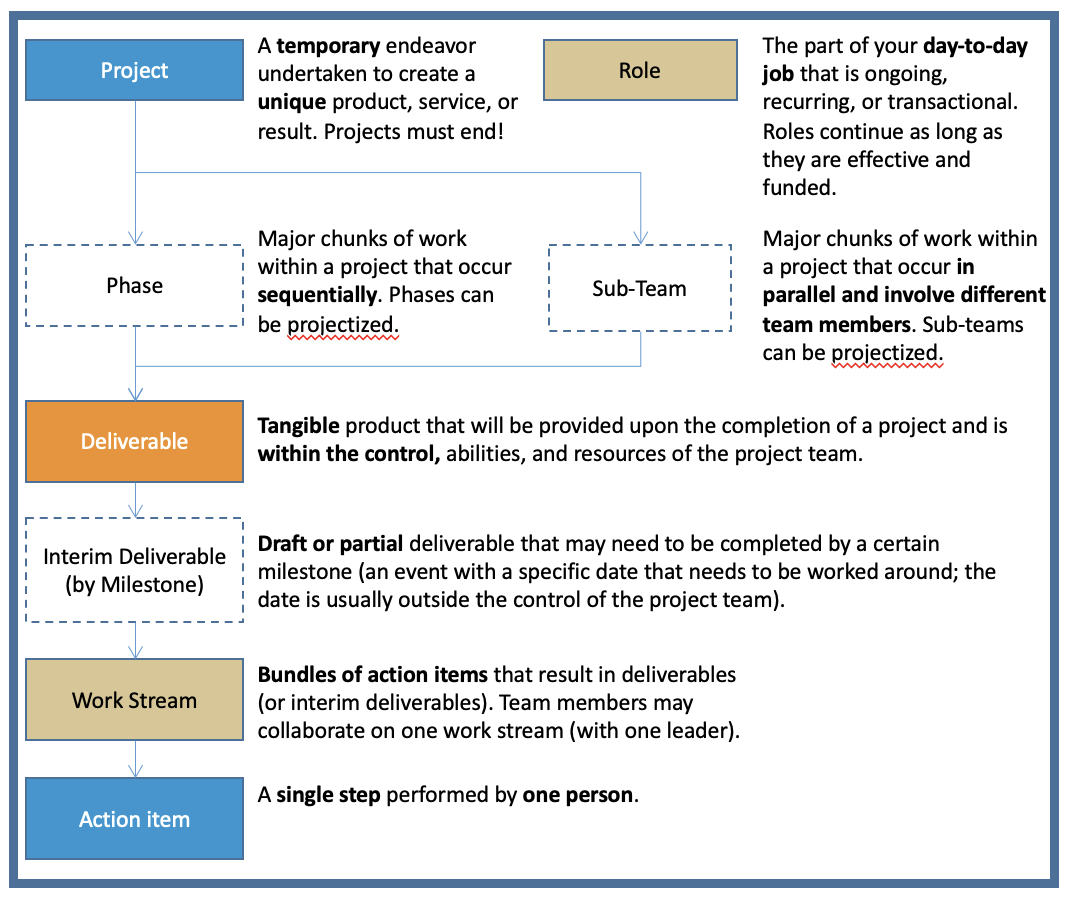
Project Management Coaching Services
Our HET Coaches and Consultants can help you and your project team improve your project management skills and achieve your teamwork goals. Drawing on our work with hundreds of projects and thousands of individual team members, we can help you learn and apply HET to make your teamwork simpler, more effective, and fun!
What is a Project?
A project is a time-bound body of work that ends with the production of one or more deliverables (also known as end products). For a project to be successful, the deliverable(s) must be completed, and when they are completed (to the satisfaction of the project sponsor), that is the end of the project. Unsuccessful projects can linger on without ending – sometimes they go into a hiatus period, and you think they will finally go away, but then they get resurfaced, maybe to the chagrin of the project team who just wants to see the project finally end.

HET Project Management Elements
What All Successful Project Teams Do
You may be leading or working on a large and complex multi-phase project. Your team is multi-disciplinary and oversees a number of sub-teams to carry out the work. Or, you may be involved in a smaller, shorter-term project with only one or a handful of deliverables. Whether your project is large or small, Highly Effective Teams® do four things well.
- Establish a clear and accountable Project Plan, including a Project Outline, a High Level Work Plan, and a Project Team Organizational Chart.
- Actively manage scope creep by applying The Triple Constraint, three factors that impact all projects.
- Practice the Four Key Skills of Team Management: Project Management, Meeting Facilitation, Team Building, and Quality Control.
- Leverage being Splitters, not Lumpers, by breaking up big projects into smaller, manageable chunks.
Project Plan
High performing teams take time at the outset of the project to align and get clear on the purpose of the project and who will do what by when.
- The Project Outline defines the promise you are making to your Sponsor and stakeholders and creates the enabling conditions for limiting scope creep.
- The High Level Work Plan shows how you will break down the Deliverables into Workstreams and when each piece of work will take place.
- The Project Team Organizational Chart allocates a capable Project Manager and authorizes other team members to spend time on the project, while clarifying roles so everyone knows what is expected of them.
The Triple Constraint
Three factors constrain every project. They exist in a state of equilibrium. One factor can’t change without one or both of the other two factors changing (like the sides of a triangle).
The three sides of the triangle are the three variables that define all projects: delivering a scope of work, on schedule, and on budget.
When one side of the triangle changes, we must adjust one or both of the other sides to ensure project success. This is how we prevent scope creep, the silent killer of successful projects.
Four Skills of Team Management
There are four skills all Highly Effective Teams need to effectively manage projects:
- Project Management: The “technical” part of teamwork – the planning and running of projects (50% of a Project Manager’s time)
- Meeting Facilitation: The “engagement” part of teamwork – the conversations and accountability in teams (20%)
- Quality Control: The “content” part of teamwork – the quality and control (and potentially some creation) of team deliverables (20%)
- Team Building: The “interpersonal” part of teamwork – the care and feeding of teams (10%)
Break Up Big Projects
Research has shown that your project will have a higher likelihood of succeeding if you break it down into smaller, more manageable chunks like phases or sub-teams. Breaking work into smaller-sized projects will increase the likelihood of finishing the project. Consider go / no go decisions as great points to end one phase and begin another (and maybe new team members). If different people are working on different deliverables, that’s a good indication that you can form sub-teams.
Module 3: Project Planning & Implementation

The first three steps to Project Planning and Implementation are Agree on deliverables, Breakdown the work, and Clarify roles. These three HET Principles are all about gaining clarity at the beginning of our work. Together, they help you and others clearly understand purpose of the project, what you will deliver, how you get the work done, and who will be involved and what roles they will have.



Module 5: HET for All

Once your project is organized and work has begun, HET helps you work as a Highly Effective Team. Drive accountability, Engage constructively, and Facilitate great meetings, Driving accountability is the process of following up to ensure that your team did all that you said you would do. When we talk about Engaging constructively, we are really talking about creating a healthy organizational culture in which happy teams can do great work. Facilitating great meetings helps you and your team create a rhythm for meeting and a process for creating and keeping agreements and making decisions.



